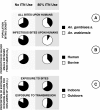Entomological surveillance of behavioural resilience and resistance in residual malaria vector populations
- PMID: 23577656
- PMCID: PMC3637503
- DOI: 10.1186/1475-2875-12-124
Entomological surveillance of behavioural resilience and resistance in residual malaria vector populations
Abstract
Background: The most potent malaria vectors rely heavily upon human blood so they are vulnerable to attack with insecticide-treated nets (ITNs) and indoor residual spraying (IRS) within houses. Mosquito taxa that can avoid feeding or resting indoors, or by obtaining blood from animals, mediate a growing proportion of the dwindling transmission that persists as ITNs and IRS are scaled up.
Presentation of the hypothesis: Increasing frequency of behavioural evasion traits within persisting residual vector systems usually reflect the successful suppression of the most potent and vulnerable vector taxa by IRS or ITNs, rather than their failure. Many of the commonly observed changes in mosquito behavioural patterns following intervention scale-up may well be explained by modified taxonomic composition and expression of phenotypically plastic behavioural preferences, rather than altered innate preferences of individuals or populations.
Testing the hypothesis: Detailed review of the contemporary evidence base does not yet provide any clear-cut example of true behavioural resistance and is, therefore, consistent with the hypothesis presented.
Implications of the hypothesis: Caution should be exercised before over-interpreting most existing reports of increased frequency of behavioural traits which enable mosquitoes to evade fatal contact with insecticides: this may simply be the result of suppressing the most behaviourally vulnerable of the vector taxa that constituted the original transmission system. Mosquito taxa which have always exhibited such evasive traits may be more accurately described as behaviourally resilient, rather than resistant. Ongoing national or regional entomological monitoring surveys of physiological susceptibility to insecticides should be supplemented with biologically and epidemiologically meaningfully estimates of malaria vector population dynamics and the behavioural phenotypes that determine intervention impact, in order to design, select, evaluate and optimize the implementation of vector control measures.
Figures


References
-
- Seyoum A, Sikala C, Chanda J, Chinula D, Ntamatungiro AJ, Hawela M, Miller JM, Russell TL, Briet OJT, Killeen GF. Human exposure to Anopheline mosquitoes occurs primarily indoors, even for users of insecticide-treated nets in Luangwa valley, south-east Zambia. Parasit Vectors. 2012;5:101. doi: 10.1186/1756-3305-5-101. - DOI - PMC - PubMed
-
- Huho B, Briet OJT, Seyoum A, Sikala C, Bayoh N, Gimnig JE, Okumu FO, Diallo D, Abdulla S, Smith T, Killeen GF. Consistently high estimates for proportion of human exposure to malaria vector populations occuring indoors in rural Africa. Int J Epidemiol. 2013;42:235–247. doi: 10.1093/ije/dys214. - DOI - PMC - PubMed
Publication types
MeSH terms
LinkOut - more resources
Full Text Sources
Other Literature Sources
Medical
Research Materials

